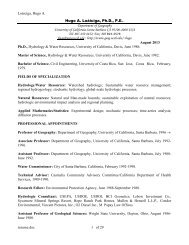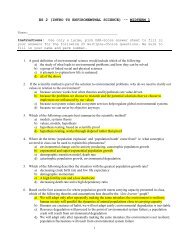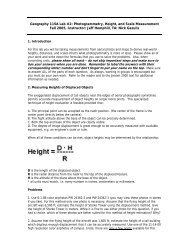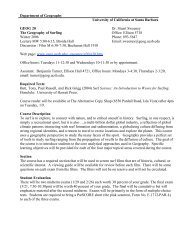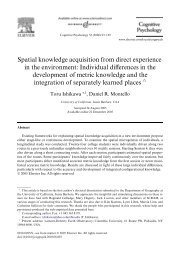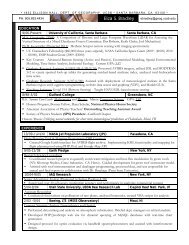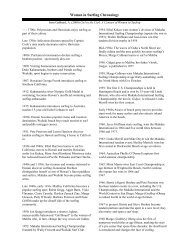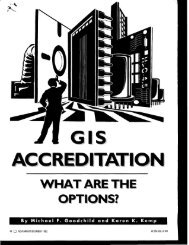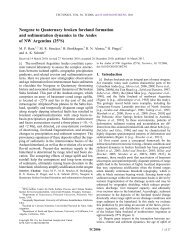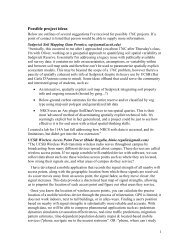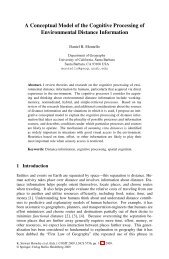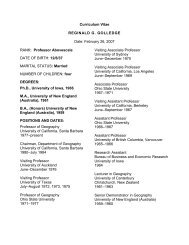Farm households and land use in a core conservation zone of the ...
Farm households and land use in a core conservation zone of the ...
Farm households and land use in a core conservation zone of the ...
You also want an ePaper? Increase the reach of your titles
YUMPU automatically turns print PDFs into web optimized ePapers that Google loves.
In a perfect world, if farmers had ample l<strong>and</strong> or o<strong>the</strong>r resources <strong>and</strong> alternative<br />
options <strong>in</strong> orig<strong>in</strong> areas, <strong>the</strong>y would never migrate to <strong>the</strong> MBR <strong>in</strong> <strong>the</strong> first place. But <strong>in</strong> <strong>the</strong><br />
real world, farmers have already settled en masse <strong>in</strong>side <strong>core</strong> <strong>conservation</strong> <strong>zone</strong>s <strong>of</strong> <strong>the</strong><br />
MBR as <strong>in</strong> o<strong>the</strong>r protected areas throughout <strong>the</strong> tropics. Governments <strong>and</strong> NGOs need to<br />
plan to maximize farmers’ well be<strong>in</strong>g <strong>and</strong> m<strong>in</strong>imize farmer impacts on <strong>the</strong> forest ecology<br />
<strong>of</strong> <strong>the</strong> reserve. Current l<strong>and</strong> <strong>use</strong> systems, <strong>the</strong>refore, must be understood to make <strong>the</strong>m<br />
more economically viable <strong>and</strong> ecologically benign. This research is <strong>the</strong> first attempt to<br />
systematically exam<strong>in</strong>e such farm<strong>in</strong>g systems with <strong>the</strong> first large detailed survey <strong>of</strong> l<strong>and</strong><br />
<strong>use</strong> <strong>and</strong> its social, political, demographic, <strong>and</strong> ecological associated factors <strong>in</strong> Central<br />
America.<br />
Return<strong>in</strong>g to <strong>the</strong> <strong>the</strong>oretical discussion <strong>and</strong> conceptual model (Figure 1), political,<br />
economic, social, demographic, <strong>and</strong> ecological dynamics shaped farm ho<strong>use</strong>hold<br />
decision-mak<strong>in</strong>g, <strong>in</strong>clud<strong>in</strong>g l<strong>and</strong> allocation <strong>and</strong> l<strong>and</strong> <strong>use</strong>, which <strong>in</strong> turn led to variable<br />
forest conversion patterns. With low labor, capital, <strong>and</strong> technology available, SLNP<br />
farmer l<strong>and</strong> <strong>use</strong> was extensive, yet even modest variability <strong>in</strong> <strong>the</strong>se <strong>and</strong> associated factors<br />
led to dist<strong>in</strong>ct l<strong>and</strong> <strong>use</strong> <strong>and</strong> l<strong>and</strong> cover patterns.<br />
Despite diverse agricultural experiences <strong>in</strong> orig<strong>in</strong> areas, SLNP colonists uniformly<br />
practiced a bush fallow, swidden maize production. <strong>Farm</strong>ers differed <strong>in</strong> l<strong>and</strong> <strong>use</strong><br />
trajectories through <strong>the</strong> extent to which <strong>the</strong>y chose to extensify or <strong>in</strong>tensify production vis<br />
a vis <strong>the</strong> <strong>use</strong> <strong>of</strong> agricultural <strong>in</strong>puts, or conversely through l<strong>and</strong> allocation to cattle.<br />
Results suggest that even <strong>in</strong> this emerg<strong>in</strong>g frontier, variability <strong>in</strong> l<strong>and</strong> <strong>use</strong> could be<br />
expla<strong>in</strong>ed by differences among <strong>ho<strong>use</strong>holds</strong> <strong>in</strong> <strong>the</strong>se <strong>and</strong> o<strong>the</strong>r related factors.<br />
Some observations corroborated expectations from <strong>the</strong> literature on frontier l<strong>and</strong> <strong>use</strong>;<br />
o<strong>the</strong>rs reflected <strong>the</strong> importance <strong>of</strong> underst<strong>and</strong><strong>in</strong>g <strong>the</strong> local context to expla<strong>in</strong> apparent<br />
<strong>the</strong>oretical anomalies. For example, relative to demographic factors, larger families with<br />
ample labor <strong>and</strong> greater food dem<strong>and</strong>s were associated with extensive l<strong>and</strong> <strong>use</strong> <strong>and</strong><br />
deforestation. The largest <strong>ho<strong>use</strong>holds</strong> managed a more extensive crop rotation <strong>and</strong> were<br />
eight times more likely to have cattle than <strong>the</strong> smallest <strong>ho<strong>use</strong>holds</strong>. This relation<br />
rema<strong>in</strong>ed strong despite <strong>in</strong>terven<strong>in</strong>g positive relations among ho<strong>use</strong>hold size, farm size,<br />
<strong>and</strong> duration on <strong>the</strong> farm. However, age <strong>of</strong> a ho<strong>use</strong>hold head (a proxy measure for<br />
demographic ho<strong>use</strong>hold cycle) was strongly related to ho<strong>use</strong>hold size, support<strong>in</strong>g <strong>the</strong><br />
effect <strong>of</strong> ho<strong>use</strong>hold life cycle effects (McCracken, et al. 2002; Walker et al. 2002). The<br />
data support Boserupian population-<strong>in</strong>duced <strong>in</strong>tensification among farms with scarce<br />
forest rema<strong>in</strong><strong>in</strong>g <strong>and</strong> high population pressure. A strong negative relation emerged<br />
between ho<strong>use</strong>hold population density <strong>and</strong> total l<strong>and</strong> <strong>in</strong> forest <strong>and</strong> percentage <strong>of</strong> l<strong>and</strong> <strong>in</strong><br />
forest, with farm size emerg<strong>in</strong>g as <strong>the</strong> key predictor (relative to ho<strong>use</strong>hold size).<br />
Ho<strong>use</strong>holds <strong>of</strong> highest population density had shortened fallow rotations, allocat<strong>in</strong>g<br />
nearly all <strong>the</strong>ir l<strong>and</strong> to crops. Ho<strong>use</strong>holds with fewer than several hectares had no fallow<br />
l<strong>and</strong>, suggest<strong>in</strong>g that short-term subsistence <strong>in</strong> <strong>the</strong> form <strong>of</strong> crop production was clearly a<br />
first priority <strong>in</strong> <strong>the</strong> hierarchy <strong>of</strong> ho<strong>use</strong>hold needs. Ho<strong>use</strong>holds met this need even if it<br />
meant spend<strong>in</strong>g all <strong>the</strong> soil nutrient capital <strong>of</strong> <strong>the</strong>ir farms with<strong>in</strong> two years.<br />
Never<strong>the</strong>less, <strong>in</strong> contradiction to Boserupian expectations, beca<strong>use</strong> <strong>the</strong> densest<br />
<strong>ho<strong>use</strong>holds</strong> were <strong>the</strong> poorest farmers with little l<strong>and</strong> <strong>and</strong> <strong>in</strong>secure l<strong>and</strong> title, population<br />
density was negatively related to agricultural <strong>in</strong>tensification <strong>in</strong> <strong>the</strong> form <strong>of</strong> cropp<strong>in</strong>g<br />
velvet bean or apply<strong>in</strong>g herbicides. This highlights <strong>the</strong> importance <strong>of</strong> underst<strong>and</strong><strong>in</strong>g <strong>the</strong><br />
local context. <strong>Farm</strong>ers most <strong>in</strong> need <strong>of</strong> <strong>in</strong>tensify<strong>in</strong>g production were <strong>the</strong> ones least able to<br />
16



